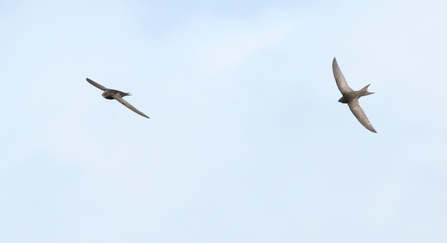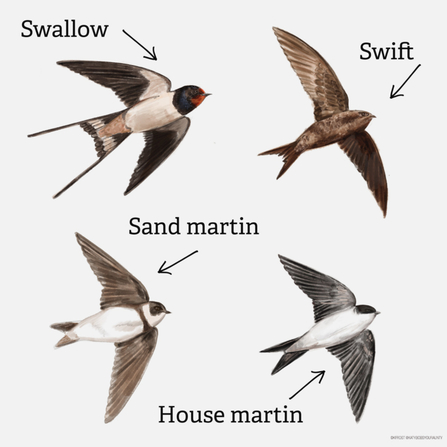Swift Awareness
We want to increase awareness of Swifts, by helping everyone to get involved, understand Swifts and take a plethora of actions that could include events, talks, leaflets, record taking, installing Swift boxes and much more!
Swift ©David Tipling/2020VISION
We want to increase awareness of Swifts, by helping everyone to get involved, understand Swifts and take a plethora of actions that could include events, talks, leaflets, record taking, installing Swift boxes and much more!

Vaughn Matthews
Swifts need help. In the UK, population numbers plummeted by 60% between 1995 and 2020. The likely causes of the decline are habitat loss (particularly nesting sites in the UK such as old buildings), unpredictable weather patterns in the UK summer as well as less food due to declining insect numbers [Source: BTO.org].
The good news is there are plenty of people taking actions to fight this decline and you can get involved too. One of the biggest impacts you can make is to install a Swift box, read our handy guide on how to make one here.

Illustrations by Katy Frost
The Swift displays a predominantly black plumage, accompanied by a small, light-coloured area on its throat. When airborne, it resembles a boomerang and exhibits a highly sociable nature. Frequently observed in flocks, these Swifts gracefully soar above rooftops, emitting distinct high-pitched cries to communicate with one another.
Distinguishing them from Swallows and Martins, which possess white undersides, Swifts are larger in size and do not perch on wires, structures, or trees.
We asked Rose Parkhouse from Chepstow Swift Group to tell us all about the amazing world of Swifts and Local Swift Groups within Gwent. We started by asking her, ‘What is it about Swifts that sets them apart from other birds?’
There’s something uniquely joyous about those summer screaming parties of Swifts careering through our towns and villages at roof height, bringing elation, fascination and admiration! These birds are very fast, very clever and they pair for life, returning to the same nest site each year. For a short season they live with us, nesting in our buildings, raising their young in our communities and making their presence felt. Why else would there be so many local groups of Swift enthusiasts throughout the British Isles?
These local groups are generally fairly small but they do great work. Swifts are now red-listed as an endangered species and local groups are doing all they can to protect them. Although insect decline is a serious concern, the main focus of the local groups usually centres on nest sites – when traditional buildings with suitable holes in the structure are developed or demolished those nest holes are lost. Swift group activities vary and can include monitoring of nest sites, organising Swift walks, installing specialist Swift nest bricks and boxes, installing specialist “calling” systems to attract the birds to those nest sites, lobbying local developers and getting involved with planning applications.
There are a number of Swift groups in the Gwent area. One group, which was only started last year, is Swifts of Usk. They have achieved a great deal in a very short time and have installed Swift nest boxes and calling systems around the town in considerable numbers. It probably helps that the group has volunteers who work in the Fire Service and are a dab hand at climbing ladders!
There is a network of local Swift groups and some of them organise events during the breeding season. Swift Awareness Week takes place when the birds are usually around in good numbers and is a way of giving a National focus to these local events – the idea is to help spread the message to the general public that Swifts need more protection. Perhaps there is something going on in your town or village? Most groups have a presence on Facebook and some have websites so maybe take a look and see what’s going on.
If you happen to live in the Chepstow area then, Chepstow Swifts would love to hear from you! We always welcome more eyes and ears looking out for nest sites and we’re also looking for volunteers to learn about calling systems and to give advice or practical help to local residents and businesses.
Facebook : Chepstow Swifts
Email: chepstowswifts@gmail.com
There are some amazing facts, such as sleeping whilst flying, covering up to 500 miles a day and almost never landing on flat ground...
Swifts typically arrive in the UK in the last week of April or early May, and their stay is limited to the breeding season.
Swifts are widespread across the UK and are often seen flying high above towns and villages as they rely on buildings for nesting.
For observing nesting Swifts, the best time is from late May to late July, either during dusk on a warm, still evening or early in the morning.
Swifts nest in the roof space under the eaves of old houses and churches, allowing them to easily take flight from the nest entrance. The nests are constructed by both adults using various materials gathered on the wing.
Swifts begin laying eggs between mid-May and early July, with a clutch size of up to 3 eggs. The chicks hatch within 5-8 weeks and will take their first flight shortly after.
After sunset, Swifts ascend to high altitudes and gradually decrease their altitude to spend the night at lower levels. Before sunrise, they rapidly increase altitude again before descending.
While some species of Swifts, like the alpine Swift, are rare in the UK, common Swifts are widespread. However, there have been sightings of rare Swifts in certain regions.
Groups of Swifts flying fast at roof height often emit loud screeching sounds, which indicates their proximity to nesting sites.
To attract Swifts to your garden, you can grow wildflowers, which provide food and shelter for insects that serve as a food source for Swifts. Additionally, wildflowers add color and beauty to your garden.
Predators of Swifts include owls, barn owls, and occasionally mammals such as rats or weasels that can climb to their nests. However, predators rarely pose a significant threat.
Apart from the nesting period, Swifts spend most of their lives in the air, continuously flying day and night. They feed, drink, mate, and even sleep while airborne, making them unique in their flying abilities.
During its lifetime, a common Swift may fly a distance of approximately 4 million miles, equivalent to flying to the moon and back eight times. They are known for their aerial lifestyle.
Recent research has shown that common Swifts can stay in the air for up to 10 months without stopping, though some individuals may go shorter durations without landing.
Swifts can cover over 800 kilometers (approximately 500 miles) per day during migration, surpassing previous predictions for small migrating birds.
Swifts have adapted to sleep and eat while in flight. Some individuals have been observed staying airborne for over three months without landing.
A group of Swifts is called a "scream," which is fitting as they often emit loud vocalizations while flying.
While Swifts are capable of taking off from level ground, they are rarely seen landing or taking off from the ground. Their physical characteristics and behavior make ground landings or takeoffs unlikely.